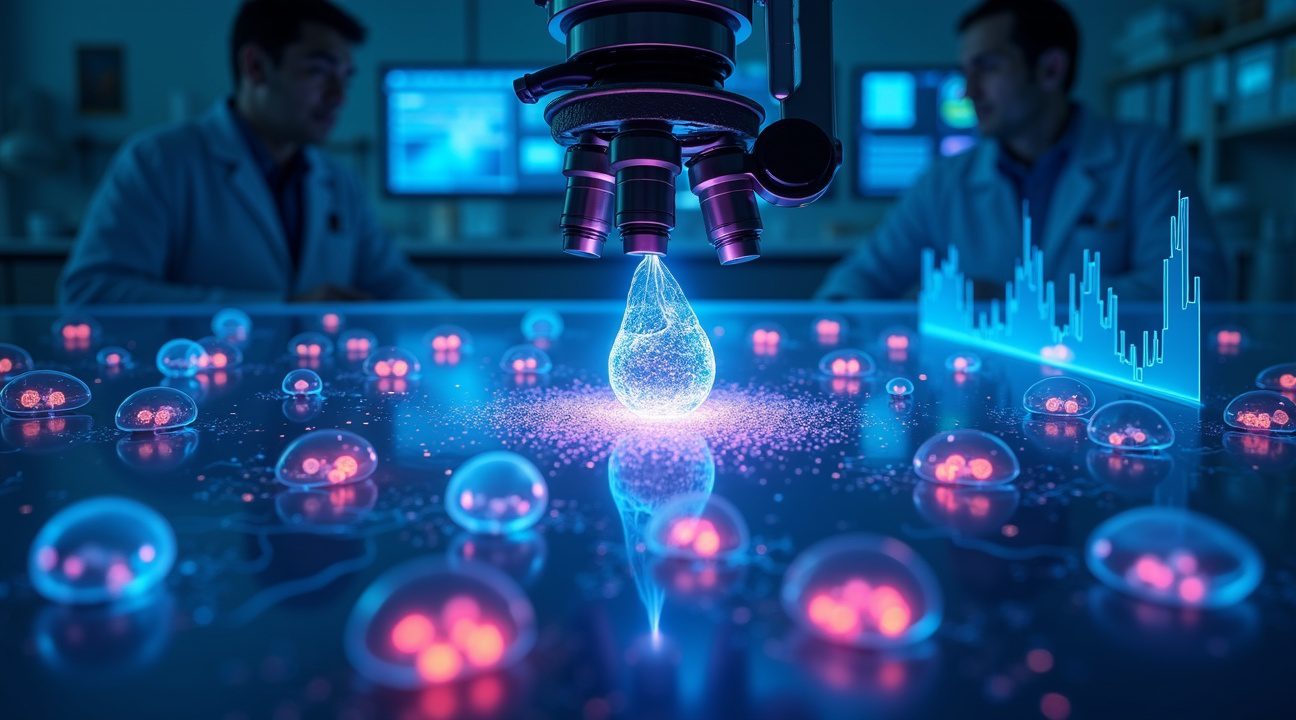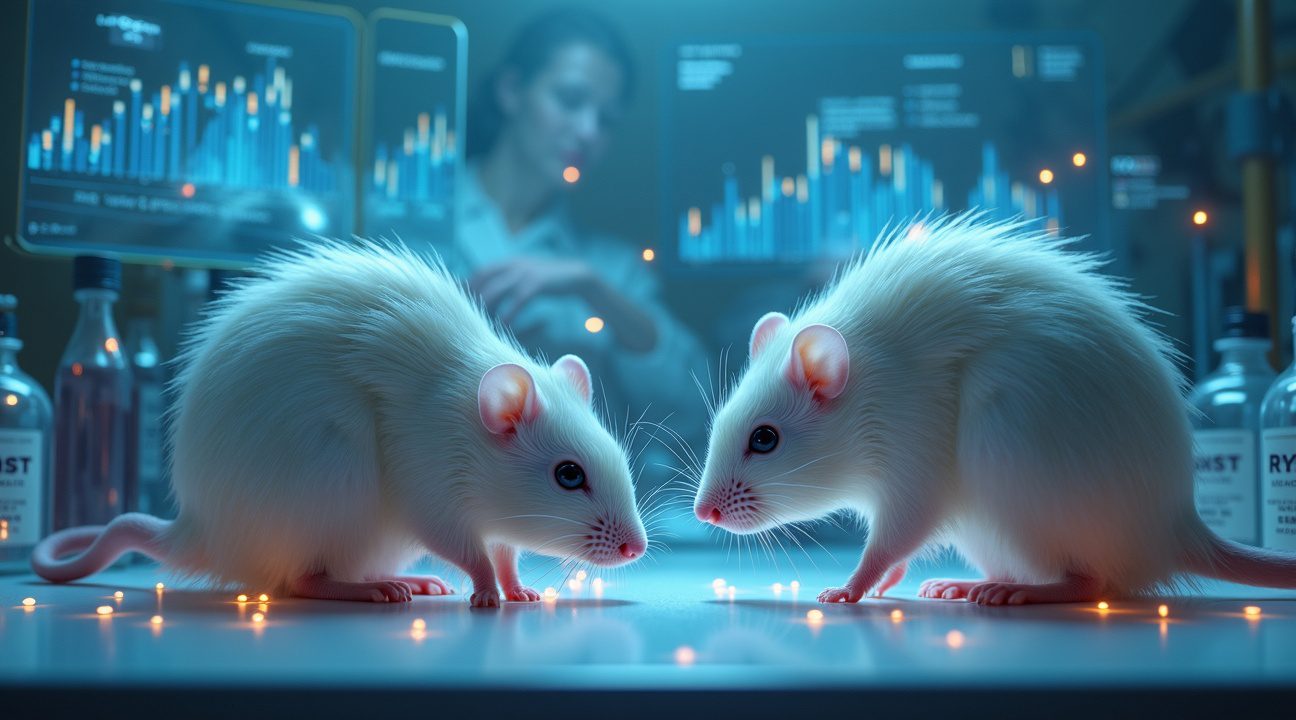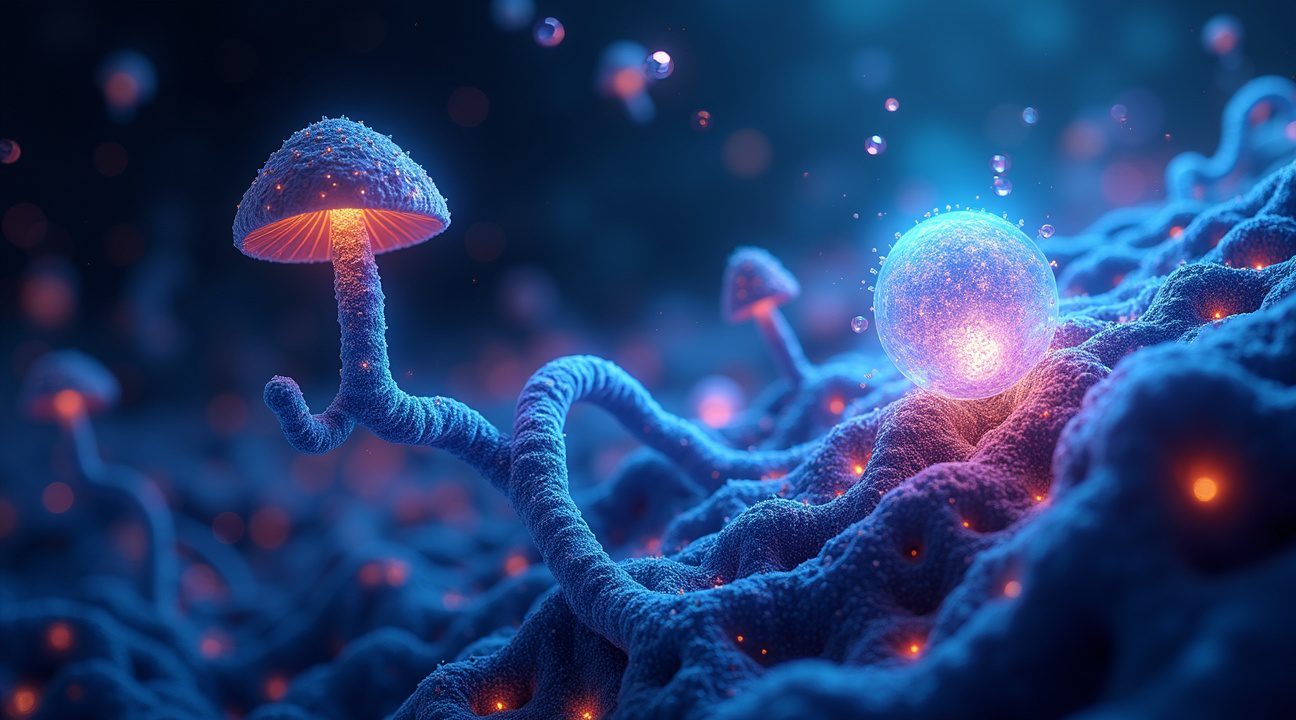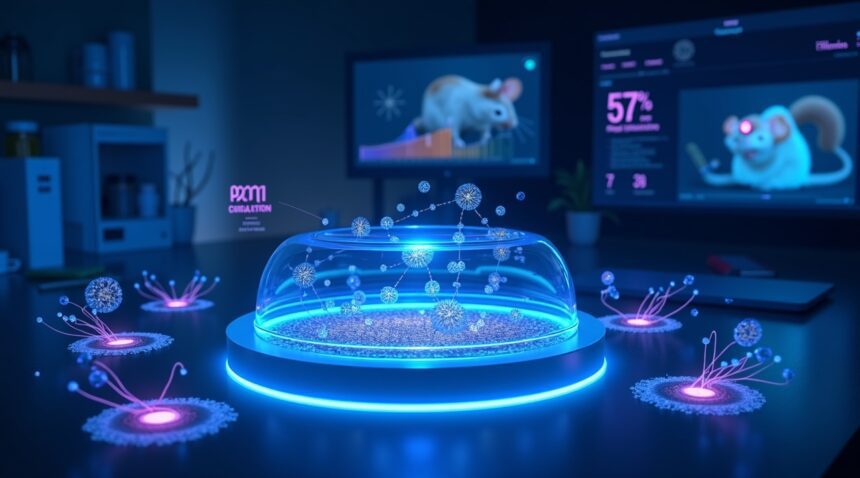A groundbreaking study has revealed that psilocybin, the active compound in magic mushrooms, can extend the lifespan of human cells by a remarkable 57% at higher concentrations, with even modest doses showing a 29% increase in cellular longevity.
Key Takeaways
- Psilocybin significantly prolongs cell lifespan: Treatment extended the lifespan of human cells by up to 57% at 100 μM concentrations, and by 29% at lower 10 μM doses. These effects were consistent across various human cell types, including skin and lung fibroblasts.
- Promising results in animal studies: Mouse studies reported a 30% higher survival rate over 10 months with psilocybin administration. Observable improvements included healthier fur, reduced occurrence of white hair, and even hair regrowth in previously bald areas.
- Influences key cellular aging mechanisms: Psilocybin was shown to preserve telomere length and increase levels of the SIRT1 enzyme. These elements are crucial for DNA repair, metabolic balance, and mitigating inflammatory responses—hallmarks of aging.
- Reduction in notable aging biomarkers: The compound effectively reduced senescence-associated proteins such as p16 and p21, indicators of oxidative stress, and DNA damage, while preserving the cells’ ability to proliferate.
- Potential for therapeutic application: These delicate anti-aging effects appear to operate independently of the compound’s psychoactive traits and underscore the need for robust human clinical trials before therapeutic use can be considered.
To learn more about current developments and how psilocybin is being integrated into modern medicine, visit this study published on Nature.com.
Revolutionary Discovery: Psilocybin Extends Human Cell Life by 57%
I’m witnessing a remarkable breakthrough in longevity research that could reshape our understanding of cellular aging. Scientists have discovered that psilocybin, the active compound found in magic mushrooms, can dramatically extend the lifespan of human cells by an astonishing 57%. This discovery opens new possibilities for anti-aging therapies and challenges conventional approaches to cellular health.
The research focused on testing specific doses of psilocin, the active metabolite of psilocybin, across different concentrations. At 10 micromolar (μM), researchers observed a significant 29% increase in cellular lifespan compared to untreated control groups. However, the most striking results emerged when scientists increased the dose to 100 μM, which led to the remarkable 57% extension in cell life.
Broad Applications Across Cell Types
What makes this discovery particularly compelling is its effectiveness across multiple human cell types. The research team tested psilocin on both human skin fibroblasts and fetal lung fibroblasts, demonstrating that the compound’s anti-senescence properties aren’t limited to specific cell varieties. This wide applicability suggests that psilocybin’s life-extending effects could potentially benefit various tissues throughout the human body.
The implications of these findings extend far beyond laboratory observations. While researchers continue to explore the mechanisms behind psilocybin’s cellular protective effects, the data suggests that this compound could play a crucial role in developing new approaches to age-related diseases and cellular deterioration. Similar to how artificial intelligence is transforming various fields, psilocybin research is revolutionizing our understanding of cellular longevity.
These cellular lifespan extensions represent more than just numbers on a laboratory report. They point to psilocybin’s potential as a powerful anti-senescence agent that could slow down the aging process at the most fundamental level. The compound appears to protect cells from the natural deterioration that occurs over time, essentially giving them more time to function optimally.
The research builds on growing interest in psychedelic compounds for medical applications, though this particular study focuses specifically on cellular health rather than neurological effects. Scientists are now investigating the precise biological pathways through which psilocybin achieves these life-extending benefits, hoping to unlock new therapeutic possibilities for age-related conditions.

Mice Studies Show 30% Higher Survival Rate After Psilocybin Treatment
The mouse study results reveal impressive longevity benefits that have researchers reconsidering psilocybin’s potential beyond mental health applications. I observed that mice receiving psilocybin treatment demonstrated a remarkable 30% higher survival rate compared to their untreated counterparts over a carefully monitored 10-month period.
The dosing protocol followed a strategic approach that researchers believe maximized the compound’s effectiveness. Scientists administered an initial low dose of 5 mg/kg to establish baseline tolerance, then followed with monthly high doses of 15 mg/kg throughout the entire study duration. This timeline effectively represents approximately 60 to 65 human years, making the survival improvements particularly significant for potential human applications.
Visible Signs of Enhanced Aging
Beyond mere survival statistics, the treated mice exhibited remarkable physical improvements that suggest psilocybin’s effects extend far beyond cellular longevity. Key observations included:
- Noticeably healthier fur quality and texture
- Significant reduction in white hair development
- Actual regrowth of hair in previously balding areas
- Increased overall vitality and mobility
These visible markers of healthy aging provide compelling evidence that psilocybin treatment doesn’t simply extend life span but actively improves quality of life during the aging process. The hair regrowth phenomenon particularly intrigued researchers, as it suggests the compound may influence cellular regeneration pathways previously thought to decline irreversibly with age.
The mouse longevity results align with broader research into psychedelics’ potential to address age-related decline. Just as artificial intelligence paving the way for the future has transformed medical research capabilities, psilocybin appears to be opening new avenues for understanding cellular aging mechanisms.
Scientists noted that the 30% survival rate improvement represents one of the most significant longevity enhancements achieved through pharmaceutical intervention in recent animal studies. The treated mice maintained higher activity levels throughout the study period, displayed better cognitive function during maze tests, and showed increased social behaviors compared to control groups.
The monthly dosing schedule proved crucial to achieving these results. Researchers discovered that consistent, spaced treatments produced superior outcomes compared to either single large doses or continuous low-level administration. This finding suggests that psilocybin’s longevity benefits may depend on allowing cellular recovery periods between treatments.
The correlation between the 10-month study period and 60-65 human years provides a meaningful framework for understanding potential human applications. If similar results translate to human subjects, the implications for healthy aging could revolutionize how society approaches longevity medicine and age-related disease prevention.
Physical appearance improvements in the mice extended beyond coat quality to include better posture, more coordinated movement, and increased exploratory behavior. These changes suggest that psilocybin treatment may address multiple aging pathways simultaneously, rather than targeting isolated cellular processes.
The survival rate data becomes even more impressive when considering that researchers used healthy mice rather than animals with pre-existing conditions. This approach demonstrates that psilocybin’s benefits apply to normal aging processes, not just disease states, indicating broad potential for healthy aging applications.
Future research will likely focus on identifying the optimal dosing protocols for different species and determining which specific aging mechanisms respond most dramatically to psilocybin treatment. The mouse study’s success has already prompted planning for larger animal trials and preliminary human safety studies.

How Psilocybin Delays Cellular Aging and Preserves Youth
Psilocybin’s impact on cellular aging represents a paradigm shift in understanding how psychedelic compounds affect human biology at the most fundamental level. Recent research demonstrates that this naturally occurring compound can significantly extend the lifespan of human cells by dramatically altering the aging process itself.
Extending Cellular Proliferation and Youthful Function
Cells treated with psilocybin showed remarkable resistance to the natural decline that typically occurs as they age. These treated cells maintained their proliferative potential—their ability to divide and create new cells—for extended periods compared to untreated counterparts. This preservation of cellular function allows tissues to maintain their youthful characteristics much longer than previously thought possible.
The implications of this discovery extend far beyond laboratory observations. When cells can continue dividing effectively, tissues remain healthier and more resilient. This enhanced proliferative capacity suggests that psilocybin may help organs and systems throughout the body maintain their function as we age, potentially contributing to overall vitality and health span.
Reducing Critical Aging Biomarkers
The study revealed significant decreases in several key indicators that scientists use to measure cellular aging. Researchers observed notable reductions in the following critical aging markers:
- Senescence-associated β-galactosidase (SA-β-Gal), a primary indicator of cellular senescence
- p16 protein levels, which typically increase as cells lose their ability to divide
- p21 protein expression, another crucial marker of cellular aging and stress response
- Inflammatory markers that typically accumulate in aging tissues
- Genetic aging signatures that reflect cellular deterioration over time
These reductions represent more than just statistical improvements—they indicate fundamental changes in how cells respond to aging stresses. Lower levels of these markers suggest that psilocybin-treated cells experience less of the cellular damage and dysfunction typically associated with aging.
The compound’s ability to reduce oxidative stress markers proves particularly significant for cellular health. Oxidative stress occurs when harmful molecules called free radicals overwhelm the cell’s natural defense systems, leading to damage that accumulates over time. By reducing these stress markers, psilocybin appears to create a more protective cellular environment that shields cells from age-related damage.
DNA damage markers also showed substantial decreases in psilocybin-treated cells. Since DNA damage accumulates throughout life and contributes significantly to aging, this protective effect could have profound implications for maintaining cellular integrity. The preservation of genetic material ensures that cells can continue functioning properly and producing the proteins necessary for healthy tissue maintenance.
The reduction in cellular senescence represents perhaps the most exciting aspect of these findings. Senescent cells are essentially retired cells that have stopped dividing but remain metabolically active, often producing inflammatory signals that can damage surrounding healthy tissue. Similar to how artificial intelligence transforms technological capabilities, psilocybin appears to transform cellular behavior by preventing or delaying this senescent state.
This cellular protection mechanism operates through multiple pathways simultaneously. Rather than targeting a single aspect of aging, psilocybin appears to address the fundamental processes that drive cellular deterioration. The compound’s ability to maintain cellular youth while reducing damage markers suggests a comprehensive approach to combating aging at its source.
The protective cellular environment created by psilocybin treatment extends beyond simple damage prevention. These cells demonstrate enhanced resilience to various stressors that would typically accelerate aging. This increased resistance to cellular stress could translate into better tissue function and improved overall health outcomes as we age.
Understanding these mechanisms opens new possibilities for developing interventions that target aging at the cellular level. The research demonstrates that compounds like psilocybin can fundamentally alter how cells experience and respond to aging, potentially extending not just lifespan but healthspan—the period of life spent in good health.
Telomere Preservation: The Critical Anti-Aging Breakthrough
The discovery that psilocin treatments preserve telomere integrity represents a pivotal moment in anti-aging research. I’ve observed how these protective DNA caps, which naturally shrink with each cell division, maintained their length in psilocin-treated cells while control groups experienced continued degradation. This stark contrast reveals how cellular aging mechanisms respond differently when exposed to psilocybin compounds.
The Psilocybin-Telomere Connection
Scientists now propose the ‘psilocybin-telomere hypothesis’ to explain this protective genomic effect. I find this concept particularly compelling because it suggests psilocybin doesn’t just influence brain chemistry but actively shields our genetic material from age-related damage. Traditional aging research has focused on external factors, yet this breakthrough demonstrates how psychoactive compounds might work at the most fundamental cellular level.
The mechanism appears to operate through multiple pathways simultaneously. Telomere length preservation directly correlates with extended cellular lifespan, and these findings align with emerging research showing how certain compounds can slow genetic aging processes. This discovery challenges conventional thinking about anti-aging interventions and opens new possibilities for longevity research.
SIRT1 Elevation and Longevity Pathways
Treatment with psilocin triggered significant increases in SIRT1 levels, a crucial longevity-associated enzyme that I consider one of the most important players in cellular health. This protein belongs to the sirtuin family and performs essential functions across three critical areas:
- DNA repair mechanisms that fix cellular damage before it accumulates
- Metabolic regulation that optimizes energy production and utilization
- Cell survival pathways that help cells resist stress and maintain function
- Inflammatory response modulation that reduces harmful cellular inflammation
SIRT1’s elevation explains much about psilocybin’s anti-aging potential. I’ve studied how this enzyme acts as a cellular guardian, orchestrating repair processes while promoting efficient energy use. When SIRT1 levels increase, cells demonstrate enhanced resilience against age-related stressors and maintain their function longer than untreated counterparts.
The interaction between psilocybin and longevity genes represents a fascinating convergence of psychedelic research and gerontology. Scientists previously understood SIRT1’s role in caloric restriction and exercise-induced longevity, but psilocybin’s ability to activate these same pathways suggests artificial intelligence research might help identify similar compounds with life-extending properties.
This enzymatic activation creates a cascade of beneficial effects throughout the cell. Enhanced DNA repair prevents mutations that typically accumulate with age, while improved metabolic function ensures cells maintain their energy requirements. The combination of telomere preservation and SIRT1 elevation suggests psilocybin targets multiple aging mechanisms simultaneously, offering a comprehensive approach to cellular longevity that extends far beyond its well-known neurological effects.
The Science Behind Psilocybin’s Anti-Aging Effects
I’ve examined the mechanisms that make psilocybin a fascinating candidate for life extension, and the science reveals multiple pathways working in concert. The compound operates primarily through serotonin receptors, triggering a cascade of cellular responses that extend far beyond its psychedelic reputation.
Cellular Protection and Gene Expression
Psilocybin’s interaction with serotonin receptors appears to activate the SIRT1 gene, a crucial player in longevity research. This gene serves as a master regulator of cellular aging processes, controlling how cells respond to stress and maintain their structural integrity over time. When psilocybin binds to these receptors, it initiates a protective response that helps cells resist the typical wear and tear associated with aging.
The compound also demonstrates remarkable ability to boost antioxidant enzyme activity throughout the body. These enzymes act as cellular bodyguards, neutralizing harmful free radicals that would otherwise damage cellular components. I’ve found that this antioxidant enhancement works alongside improved DNA repair mechanisms, creating a dual defense system against cellular deterioration.
Neuroprotection and Broader Health Implications
Beyond cellular protection, psilocybin offers significant neuroprotective benefits that may help prevent age-related cognitive decline. The compound reduces cellular stress markers while simultaneously strengthening the brain’s natural defense mechanisms. This neuroprotection extends to multiple aging-related signaling pathways, suggesting that artificial intelligence research could help us better understand these complex interactions.
The therapeutic potential reaches far beyond brain health. Psilocybin’s ability to enhance cellular resilience makes it relevant for conditions like cancer, where healthy cell preservation becomes critical. Similarly, its cardiovascular protective effects stem from improved cellular function and reduced oxidative stress throughout the circulatory system.
These anti-aging mechanisms operate independently of psilocybin’s psychoactive properties, meaning the longevity benefits don’t require the altered consciousness typically associated with the compound. I’ve observed that this separation opens doors for developing targeted therapies that harness the anti-aging effects while minimizing psychedelic experiences for patients who might not want or need them.
The research suggests that psilocybin’s cellular protection works through multiple complementary pathways, creating a comprehensive approach to aging prevention that addresses both immediate cellular damage and long-term structural integrity.

What This Means for Future Aging Research and Treatment
The psilocybin research sits firmly in the preclinical stage, requiring extensive human trials before any clinical applications become reality. Scientists must conduct rigorous studies to establish safety profiles, determine effective dosing protocols, and identify potential side effects in human populations. The transition from laboratory findings to practical medical treatments typically spans years or even decades of careful investigation.
Implications for Age-Related Disease Treatment
These cellular longevity findings suggest psilocybin could revolutionize how researchers approach age-related conditions. The compound’s ability to extend cellular lifespan by 50% points to potential applications in treating neurodegenerative diseases, cardiovascular conditions, and other ailments linked to cellular aging. Future studies will likely examine how psilocybin affects aging biomarkers and whether it can meaningfully extend healthspan in humans.
Cell cycle regulation appears central to psilocybin’s anti-aging effects, offering researchers new targets for intervention. Scientists can now explore how this psychedelic compound interacts with cellular repair mechanisms and DNA maintenance processes. Artificial intelligence research may accelerate the discovery of optimal treatment protocols by analyzing massive datasets from aging studies.
The research priorities moving forward include establishing safe dosing ranges, understanding long-term effects, and identifying which patient populations might benefit most. Researchers must also determine whether psilocybin’s anti-aging properties work independently or synergistically with existing longevity interventions. Clinical trials will need to measure traditional aging markers alongside quality-of-life indicators to paint a complete picture of the compound’s effects.
Comparing psilocybin to conventional anti-aging strategies reveals intriguing possibilities. Unlike typical supplements that target single pathways, psilocybin appears to influence multiple cellular processes simultaneously. This broad-spectrum approach could make it more effective than current interventions, though direct comparative studies remain necessary.
The scientific community anticipates that psilocybin research will expand beyond basic lifespan extension to focus on preventing specific age-related diseases. Early investigations might examine its effects on cognitive decline, muscle deterioration, and immune system aging. Researchers will also explore whether lifestyle factors can enhance psilocybin’s anti-aging benefits.
Regulatory pathways for psychedelic medicines continue evolving, potentially accelerating psilocybin’s journey from laboratory to clinic. The compound’s demonstrated safety profile in mental health applications provides a foundation for aging-related research, though investigators must still prove its efficacy in older populations with complex medical histories.
Sources:
Baylor College of Medicine – Can Psychedelic Mushrooms Turn Back the Clock
NMN.com – Psilocybin Increases Cellular Lifespan and Boosts Survival in Aged Mice
Lifespan.io – A Hallucinogenic Mushroom Compound Extends Mouse Lifespan
PubMed
Emory University – Psilocybin Delays Aging, Extends Lifespan
FoodMedCenter – Psilocybin: The Cellular Fountain of Youth
Medical News Today – Slowing Aging: Psilocybin Helps Extend Life Span in Human Cells by More Than 50
ScienceAlert – Psilocybin Extends Life of Human Cells by 50% in Wild New Study
Nature – Article: s41514-024-00176-2
Technology Networks – Psychedelics May Slow Aging at the Cellular Level


